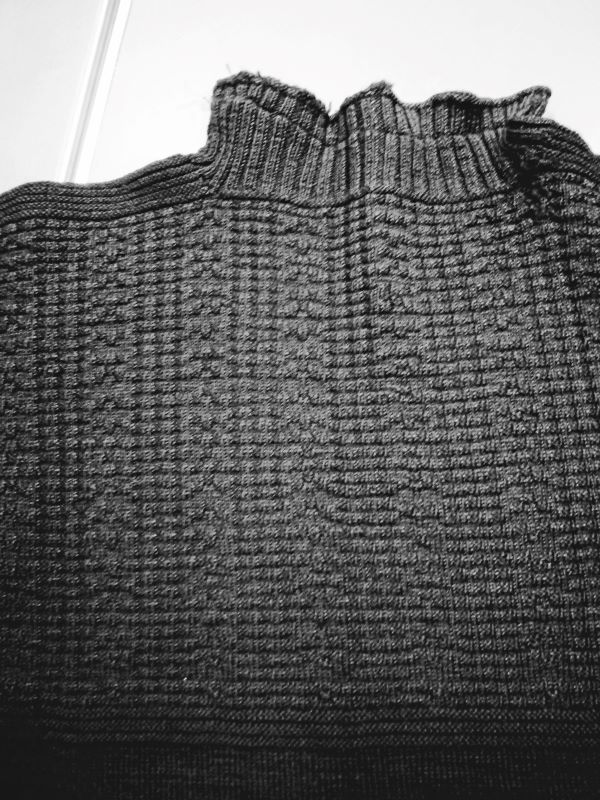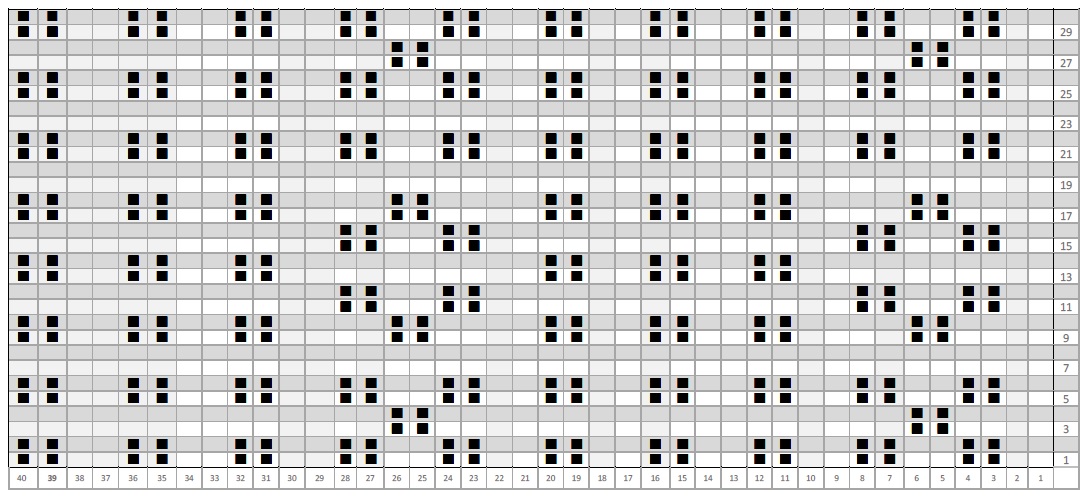| Record number | GP23 |
| Identification | |
| Simple name | gansey pattern |
| Full name | Betty Martin & irregular chequerboard & vertical & indigenous |
| Other name | David Cooper's Wells-next-the Sea 'Betty Martin' and chequerboard pattern |
| Classified name | 4.151.721 |
| System | SHIC |
| Brief description | Gansey pattern, David Cooper's gansey found at Wells next the Sea but not certain if knitted in Sheringham or by a Scots fisher lass; a curious but subtle design of columns of very regular Betty Mart and a strangely irregular chequerboard columns with purl tetrads arranged in quincunx and chevrons |
| Association | |
| Nature | wearer |
| Person | fisherman : Cooper, David |
| Place | & Wells next the Sea & Norfolk |
| Activity | fishing |
| Date | |
| Note | David Cooper was from Sheringham but moved to Wells-next-the-Sea for the whelk fishing |
| Production | |
| Method | hand knitted |
| Person | knitter : |
| Date | 1939 (pre) |
| Note3 | The use of mother-of-pearl and (?) jet for buttons suggests a pre-World War 2 date |
| Place | & & Scotland (?) |
| Place | & Sheringham & Norfolk (?) |
| Technical data | |
| Note3 | tension |
| Note | 'A' columns are Betty Martin. The irregular pattern of 'B' columns go: quincunx; blank; down chevron; up chevron; a pair; up chevron; quincunx; blank; down chevron; blank; up chevron; blank; quincunx; singleton; down chevron; down chevron; blank; up chevron; blank; quincunx; blank; down chevron; quincunx; blank; double quincunx; blank |
| Preproduction | |
| Simple name | gansey |
| Reference number | CRRMU : 1986.2 |
| Institution3 | Cromer Museum |
| Note | |
| Photography | |
| Type | digitised image |
 GP23_2.jpg |
|
| Type3 | |
| Photography | |
 GP23_1.jpg |
|
| Type3 | digitised image |
| Photography | |
 GP23_3.jpg |
|
| Type3 | digitised image |
| Research | |
| Result | pattern chart |
| Person | charted by : Warren, Martin |
| Person | swatch knitted by : Smith, Val |
| Date | 12.2019 |
| Documentation | |
 GP23.jpg |
|
| Reference number | GP23_chart.pdf |
| Documentation group | |
| Documentation | |
| Link | wells.html |
| Recorder | Warren, Martin : 19.11.2017 |
| Notes | |
| Note | When considering the origin of this pattern there are tiny pieces of evidence which suggest that it is Scottish. Firstly information given at the time of collection in Wells next the Sea suggested that it was either knitted in Sheringham or by a Scots fisher lass visiting Great Yarmouth - they weren't sure which, but it wasn't knitted in Wells. David Cooper moved to Wells for the whelk fishing. The herring lasses were great knitters and supplemented their income selling ganseys to the local fishermen wherever they went. Knitted into the fabric of the gansey is a hair and it is red in colour. Scotland has the highest prevalence of red hair of any country in the world (13% according to Cosmopolitan magazine; 6% according to Wikipedia), while Norfolk, in common with other counties on the eastern seaboard of England has fewer than average for the UK - only 2-4%. (The Guardian). |
| Note | The second line of evidence is the irregular nature of the 'B' columns. This has never been seen in any Sheringham gansey and evidence from Jonathan Emery testified that Sheringham women would not allow errors in their ganseys, preferring to pull the knitting back and correcting it before continuing. Close examination of some Sheringham ganseys shows that this is not always the case; there are errors but they are not obvious. One Yorkshire gansey (GP23) also has an over-size round of meshes compared with all the others but it is very subtle. This gansey on the other hand has a very irregular distribution of purl stitch tetrads (groups of 4 in a square). They are arranged in quincunx (groups of 5), chevrons (pointing up and down) and in pairs and sometimes interspersed with two rows blank. The pattern so produced is consistent right around the gansey, so it is not just a single error. After a great deal of study I cannot be certain if this is a deliberate counterpoint to the 'A' columns of Betty Martin, which are a rigidly grid-iron, or whether is is simply sloppiness! I have noticed that the great gansey patterns avoid stuccato repetition, preferring something more subtle. |
| Note | The use of buttons at the neck is also another Scottish trait, although it is not restricted to the Scottish fleet. The organic materials used for buttons suggests a date before the Second World War when plastic buttons began to come in. |
| Note | My conclusion errs on the side of a Scottish origin, in that it is a relatively plain all-over pattern (albeit with the subtle columns of Betty Martin and chequerboard) and so perhaps more likely to be commercially produced than home-made. Then the red hair knitted into the garment corroborates the conclusion (but does not prove it). Baysian logic suggests Scottish. So here is an example of gansey patterns spreading through the fisherfolk population around the North Sea by work-related migration. |
| Notes | Willie Cooper (b. 1905) lucid. East End, Wells next the Sea Fakenham 710448 |
|
|
|